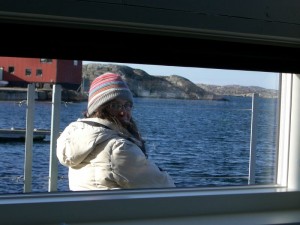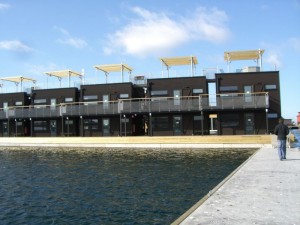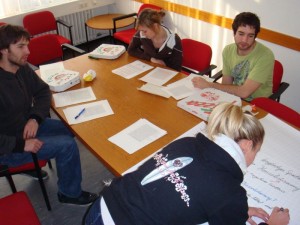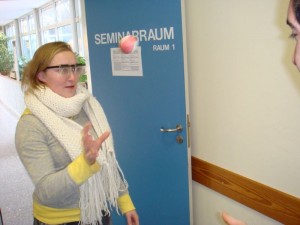What Is A Lucid Dream? (NightReport No. 2 - 22.04.1999)
Vor genau 10 Jahren war ich für ein Praktikum an der Stanford University bei Stephen LaBerge. Während der vier Monate verbrachte ich einige Nächte im Schlaflabor. Um mir die Zeit zu vertreiben, habe ich ab und an einen NightReport verfasst und an alle geschickt, die in meinem E-Mail-Verteiler waren. Nun will ich das 10-jährige Jubiläum nutzen, um die alten Reports in meinem Blog erneut zu veröffentlichen. Hier nun der zweite NightReport:
Do you think you are awake when you read this mail? Better look away and than look again on the screen…. Is this mail still there? Well done my friends! it seems you guys are awake!!! Nathen is not. He just crossed the boarder to sleep stage 2. He shows some really nice sleep spindles and some k-complexes. Well, but he has a hard time to sleep in a little box like the booth. Anyway, he’s a subject for science, thus, he shouldn’t complain about small details ;-) Sorry about the long break, but we had problems with our equipment. Now we have a modified head-box, the pre-amplifier for the SynAmp. So far, everything looks perfect. by the way, tonight was my first night to put electrodes on by my own and I can say, after just 5 hours I finished the application. No, no for the electrodes it took me just 2 hours, but after that Stephen came and we made some checks and I had to replace some electrodes… I’m getting better because we will have recordings almost every night now. I used the break to read about EEG and motor-movement. Probably I’ll have the chance to add some experiments to get some data for some interesting stuff about motor-control in lucid dreams, but I guess this is a topic for another night-report. Okay, it’s 12:40 and Nathen… Looks still like sleep stage 1… hmmm… recordings in a sleep lab are sometimes not really easy for the subject when there are a lot of new impressions and stuff like the booth, the head-box, the electrodes, etc. and than people have very specific sleep habits. Nathen right now has a mizillion kilowatt fan right in front of his face (he is from Texas). I’m drifting away from my topic for tonight…. LUCID DREAMS!!! Lucid dreams are dreams in which you recognize that you dream. Your attention is coming back and you know that you dream. What’s the big deal? After you realized that you are in a dream two things will change. First, your vision is getting clear (also your mind). You are aware of the fact that you are right now in your bed and sleep but with your dream-body you move around in your dream-world. Control is one of the things you will miss when remember a usual dream. Second, in normal dreams things happen with you, but in lucid dreams you can control your dream. No limitation! Everything what happen is in your mind and in your mind there is no gravitation. So, why walk… just fly away… why be in Corvallis and stand in the rain. Imagine yourself to Hawaii. You have never been to Hawaii? Then create your own Hawaii… actually, this is not that easy. You have to practice a lot before you can do thinks like that. In the beginning you are not really sure if that is really possible. Thus, maybe your first try to walk through a wall will end in some dream headache. Sorry, I’m getting tired and these are the only hours sleep I can have. After the beginning of the night, Nathen will start to dream more frequently and I don’t want to miss that part. soo…How can you be sure that this is not a dream??? This link leads you to the “Lucidity Homepage” and answers some FAQ [what is a lucid dream?]. What follows is an example of a Lucid Dream from Nathen (details about the Experiment during the lucid dream at the bottom of the page):
For some reason, I realize I am dreaming. I vaguely recall that this was the result of noticing some incongruity in my environment. I find myself in a house. I command the dream figures to watch me. They consist mostly of dream relatives and friends. I signal LRLR. For 30-45 seconds, I attempt to do the experiment, but everytime I position my feet to begin, I lose my balance. During this time, I may have made another lone LRLR signal. At some juncture, I make a LRLR, CW, LRLR. Again, I lose my balance. I think I made this movement after walking outside, but I am not for sure. The dream sways before my eyes as I trace the CW circle. Next, I am outside for sure. I position myself for the experiment. Once again, I lose my balance. Then, to get the dream more stable, I walk around for a bit. I give a LRLR signal. I think that I did not make the signal very well. After a short pause, I follow with another LRLR signal. I wonder if Daniel will think I am giving a waking signal. Once more, I lose my balance. This last LRLR sequence may have occurred before the LRLR, CW, LRLR signal, but I think I have it right. Also, I may have given a couple of other LRLRs that I am not accounting for. Next, I notice there are a lot of dream figures around. I do not want them to interfere with the experiment. I fly away to get to a place of solitude. There is a small girl with black hair on a skateboard. I think that she may try to follow me or fly into the air after me. I fly above the neighborhood streets. Then I notice the girl is following me on her skateboard. Some buildings come between her and I. I turn around to trick her and fly back toward where I came from. I look for a place to land. I find that trees obstruct my path so that I cannot land. I look for a clearing and then wake up. I give a waking LRLRLRLR. I call Daniel.
Experiment Instructions
EYESIGNALS: All signals should be done by moving the eyes to the extreme left as quickly as possible, and then with as little delay as possible, immediately to the extreme right, again as rapidly as possible, and so on. It is as if one is looking at one’s left ear, then right, then left, right, and back to center. The initial Lucidity onset signal (LRLR) may serve double-duty, also marking the beginning of Task A. Here the correct sequence for a Lucid Dream:
- LRLR Mark Lucidity onset
- LRLR Mark onset of task A
- Task A
- LRLR Mark end of task A, beginning of task B
- Task B
- LRLR Mark end of task B
- LRLRLRLR Mark awakening
TASK A: Clockwise-Circle (CWC). Begin by pointing with your right index finger straight ahead with your arm fully extended. Point with your right index finger to the 12 o’clock position of an approximately 18″ clock at arm’s length. Focus your eyes on the fingernail of your index finger and move your finger and arm clockwise in a circular path around the clock, smoothly describing a full circle. The smooth circle tracking should take 4-5 seconds. (So for example, 12 o’clock at time=0 sec; 3 o’clock at time=1 sec; 6 o’clock at time=2 sec; 9 o’clock at time=3 sec; and back to 12 o’clock at time=4 sec.) Make sure that the movement is continuous and as smoothly uniform in speed as possible. After completion of the CW circle, move your finger and gaze to the center.
TASK B: CounterClockwise-Circle (CCWC). Same as Task A except you perform a CounterClockwise-Circle (CCWC) instead of a clockwise-circle.
Weitere Bilder von meinem Aufenthalt in Stanford finden sich auf meiner alten Homepage!




























